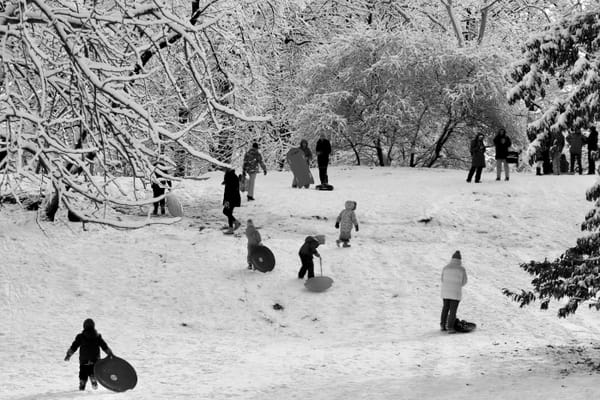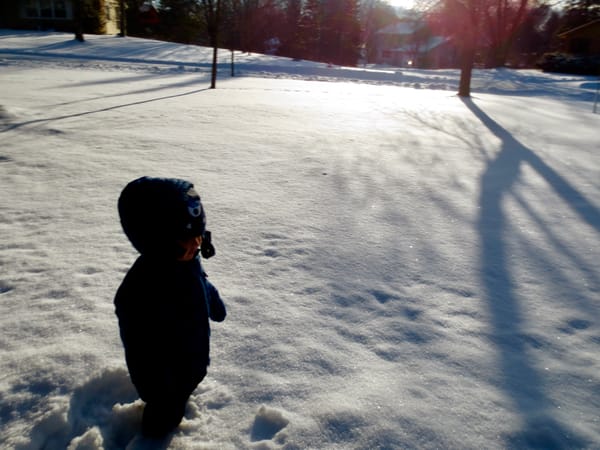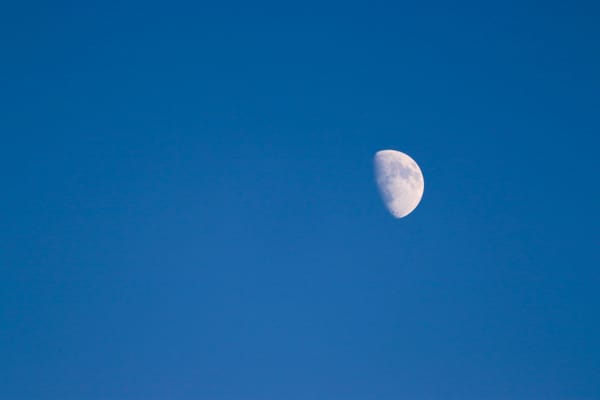The Persistence of Beauty
A love letter to subway musicians

“The sunlight comes in transitory gleams.
And yet the darkness makes the light more sweet…”
~Joyce Kilmer
A couple weeks ago I was in the West 4th Street subway station with my son at the end of an extremely long, very hot day. New York in July and August is basically a tropical climate, and the air in subway stations is particularly oppressive, thick with the accumulated heat and humidity of the season and the hot, gritty exhalations of the passing trains.
Despite all the failings of New York’s transportation system, I’m grateful for it. It is a miracle of urban infrastructure, if a rusty and underfunded miracle. I’ve spent a few brief periods of my life living in cities that were not connected in every corner by a web of trains and buses, as New York is, and it fundamentally changes the calculus involved in planning day-to-day life, as well as the equity of access to all of a city’s resources. This was particularly clear to me as we stood in the West 4th Street station, because our exhaustion that evening was entirely due to having been stranded earlier in the day by a barely functional transportation system in a nearby city.
The point of all of this is that we were very tired, a little grumpy, and extremely eager to no longer be standing on a grimy, overheated subway platform, despite my gratitude that we were finally back in a transit system where trains were indeed running. As we slumped in the heat, glancing every few seconds at the sign displaying the wait time for the next train, a little farther up the platform a musician was taking out his trumpet. “C’mon,” I said to my son, “Let’s go wait up there.” I love subway musicians.
Beauty often has to work hard to break through the cracks here. Whether it is the beauty of wildlife making its way, improbably, amidst concrete, or the sunset casting a glowing light that cuts perfectly through the urban canyons, or a musician filling the subway tunnels with unexpected harmony, beauty has to make space where space is hard to come by.
The trumpet player we listened to that night stood in front of the cracked, stained tiles of the station walls, and as he played, a few people started dancing under the fluorescent lights of the platform. Yes, we have Carnegie Hall and Broadway and the Temple of Dendur. New York is not short on impeccably curated sites for the display and admiration of beauty. But these other moments, when beauty arises suddenly without our careful preparation, these are the meteor showers of urban life. It’s a different kind of beauty, a more insistent, organic, and surprising one.
The kind of beauty that echoes through a subway tunnel requires determination. It requires openness to possibility, even in literal darkness, and a willingness to remain engaged and connected, even when we are weary. The beauty of a jazz trumpet as it ricochets through the thick air of a subway platform is a reminder that we always have the ability to create beauty and joy whatever the circumstances. It’s a form of beauty that feels uniquely honest and resonant with the experience of being human, which, most of the time, has more in common with a subway station than the red velvet womb of a concert hall. The music we find underground reminds us that beauty and joy are everywhere, no matter how bleak our surroundings might seem, no matter how exhausted we may be. Opportunities to be bathed, even for a few minutes, in something that lifts us up are everywhere. Just as flowers occasionally grow between the cracks in the sidewalk, Beethoven or Nat King Cole can await us in an underground tunnel, pulsing with the summer heat and greasy with the passage of millions of human bodies. We can be lifted up in the most unexpected moments, and the promise of that is nourishing and sustaining.

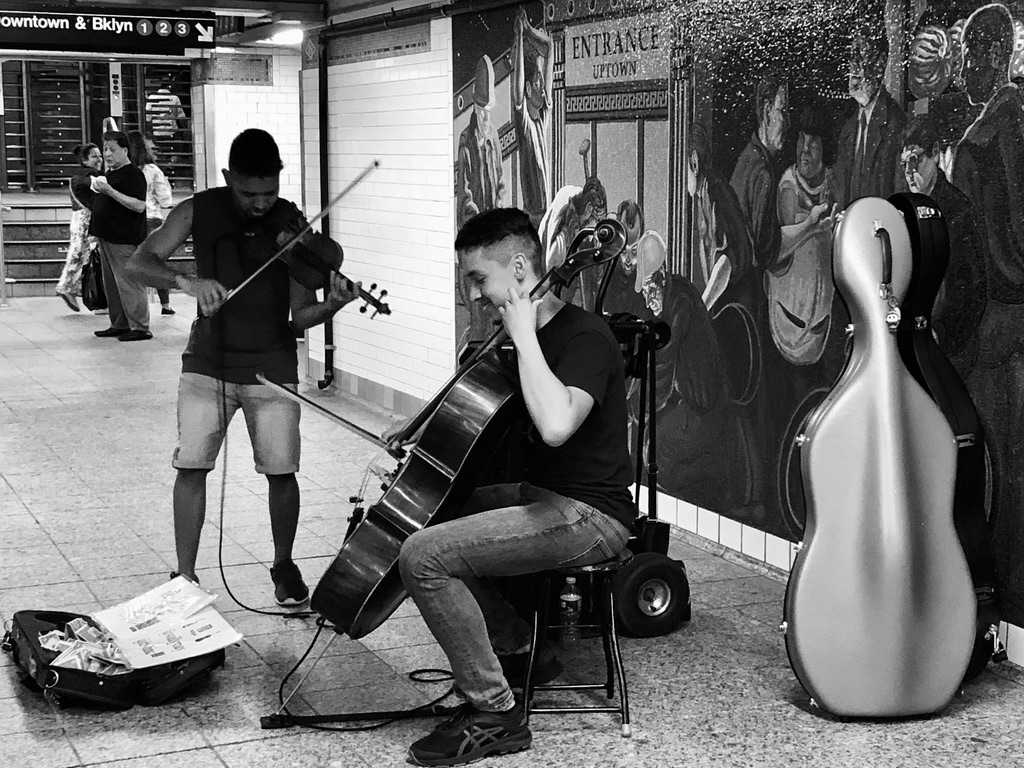
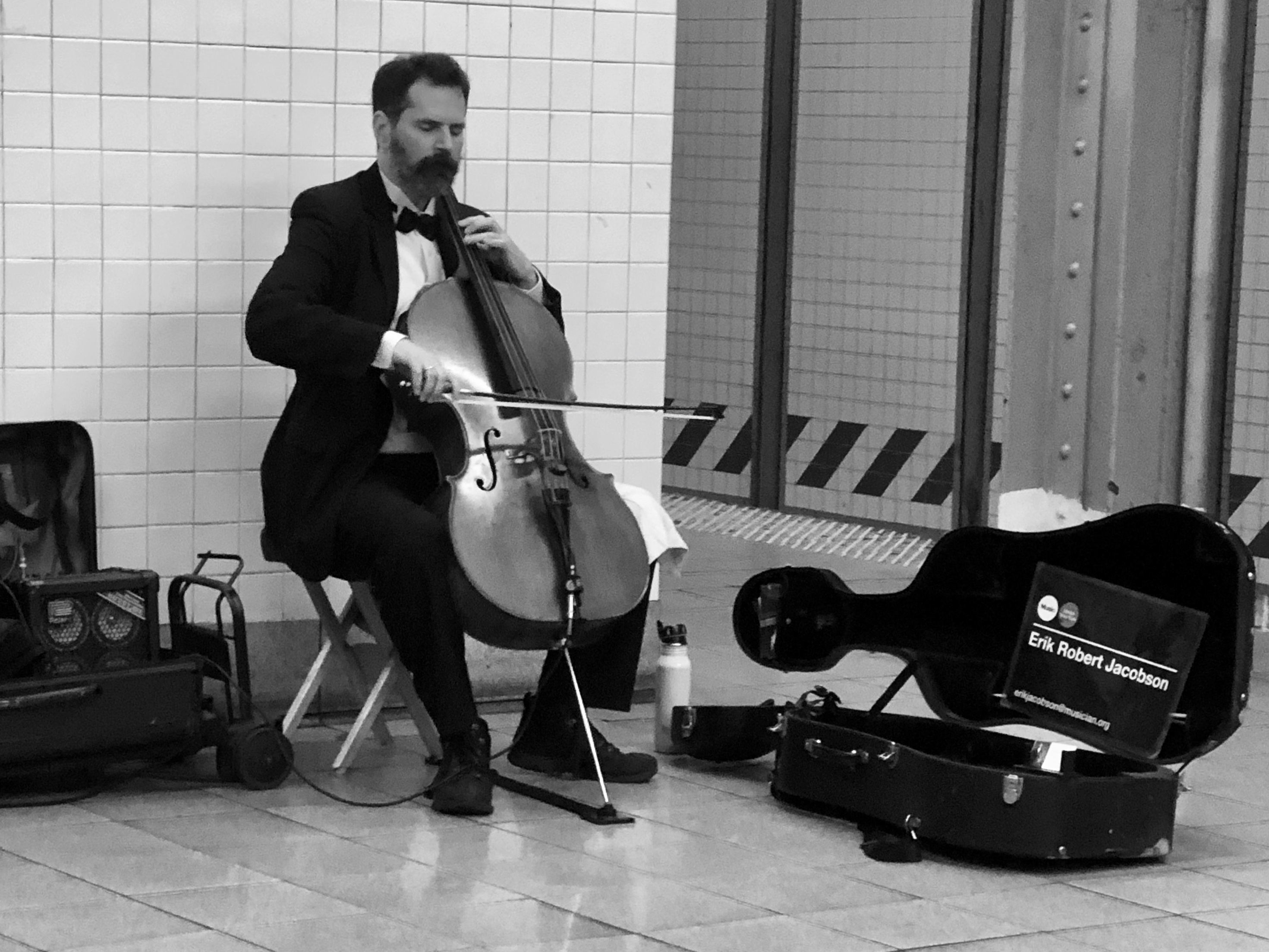
A few of the other musicians we've stopped for along the way
There is also something powerful about the fact that these moments of beauty and promise are human made. So much of what we have created extinguishes beauty, and nowhere is this more palpable than amidst the cement and smog of urban environments. As I’ve written before, nature still manages to slip through the cracks, but so often in the age of the Anthropocene, we are reminded of all the ways in which we have obliterated beauty. It can be hard to remember the ways in which we are also capable of creating it. And yet there is music, even in the dark of the subway, reminding us of the best that we can summon into existence, even as the cracked tiles and polluted air keep us rooted in the grind of more practical and often disheartening realities. Music in subway tunnels gives us a taste of the best of ourselves, while not allowing us to forget that we have to work to hold onto these higher capacities.
And aren’t most of the highest forms of our humanity like this—our compassion, our creative potential, our ability to express, not only the rational and pedestrian, but the ineffable? These are the parts of ourselves that we have to strive to recognize and to elevate. This is why I always try to walk to the end of the platform where a musician is playing. Our willingness to pause for beauty in unexpected places is a small but useful act within the larger work of lifting up our capacity for joy and care.
Kant said, “The beautiful is the symbol of the morally-good.” This connection is not about elevating beauty in the commercialized and commodified way we typically understand it today. Rather, Kant described experiences of beauty in which he said, “the mind becomes conscious of a certain ennoblement and elevation above mere sensibility to pleasure from impressions of sense.” I think the connection between beauty and morality, considered through this framework, lies in the kind of attention both require and the ways in which they lift us beyond the ordinary. A concerto weaving its way through a subway tunnel, a few green leaves pushing their way through concrete or steel, or a gesture of kindness in the face of cruelty—all reveal glimpses of something greater than our individual fixations, and they remind us of the tenacity required to choose this possibility.
I’m reminded also of a 2007 journalistic experiment in which the violinist Joshua Bell performed just outside the DC Metro. He performed for 43 minutes, as over 1,000 people passed by, and only a handful stopped. Gene Weingarten, the journalist who conducted and described this experiment, noted himself that Kant would not have blamed the commuters of a moral failing for passing by the beauty of Bell’s violin, despite his belief in the marriage of beauty and morality. As Weingarten explained, Kant recognized that the conditions for appreciating beauty matter, and certainly the conditions in a public transportation hub are working hard against beauty, not only because the environment itself is often so lacking in beauty, but because these are the spaces in which the practical obligations of our daily lives tug at us most harshly. We not only have to recognize that beauty is occurring in our midst, despite an environment that is decidedly distracting and unbeautiful, but we also have to be able to set aside the many very real stresses and challenges that fill our days and make it so hard to pause.
And yet, just as the circumstances for recognizing and appreciating transcendent beauty are often not ideal, the circumstances for moral decision making are also rarely ideal. One doesn’t have to step out of the subway to see how direct this connection is, for the subways are filled with at least as much suffering as music, and we walk past these human moments everyday as well. So many things make it hard for us to stop, whether for a symphony or to feed someone who is hungry, help someone who is hurt, or talk to someone who is lonely.
A particularly striking data point in the Joshua Bell experiment, though, was the fact that the only demographic group to consistently be drawn to Bell’s music was children. Weingarten wrote,
“There was no ethnic or demographic pattern to distinguish the people who stayed to watch Bell, or the ones who gave money, from that vast majority who hurried on past, unheeding. Whites, blacks and Asians, young and old, men and women, were represented in all three groups. But the behavior of one demographic remained absolutely consistent. Every single time a child walked past, he or she tried to stop and watch. And every single time, a parent scooted the kid away.”
I don’t think that children were demonstrating an inherent moral superiority in their pull toward Bell and his violin. But, for the most part, children are less burdened by the practical demands and very real stresses that compel adults to tune these moments out in order to hold the tenuous patchwork of our daily lives together. This is where I think it is significant that Kant offers us some grace when the context is not ideal. But it also points to how powerfully the context we have created in our extremely busy, pressured culture—in which so much of our lives often feels precarious—prevents us from noticing, let alone stopping, for anything that interrupts those pressures or threatens to throw them out of balance.
Just as children noticed and were drawn to the violin music outside the DC Metro, they are also often highly observant of and curious about suffering, closely attending to and questioning circumstances that adults are conditioned to look away from so that we can keep moving. Children, by virtue of being less consumed by obligation, may not be morally superior, but I do think their attention is worth taking note of. Because their field of vision is less cluttered and strained, they are often able to be the canaries in the coal mine, alerting us to the notes of both joy and pain in our midst, which we adults, otherwise, often fail to see.
The other observation worthy of note among the commuters who did stop to listen to Bell was the response of one man, who, in determining that he was three minutes early for work, paused and listened for exactly that amount of time. Though he was not able to eschew the practical responsibilities of his day, as most of us realistically are not, he chose to allow himself those few minutes to be drawn into beauty. And, when interviewed later about why he stopped, he explained that he was not knowledgeable about classical music, but he said, “Whatever it was, it made me feel at peace.”
In the picture book, Wait by Antoinette Portis, an observant and curious child repeatedly calls out to his mother to wait, noticing many enticing provocations along their journey. His mother responds each time with, “Hurry,” a conversational duet any parent who has ever been in a rush while holding a toddler’s hand will recognize. Of course this is how we respond. So much in our adult lives compels us to hurry. I find the mother in this book deeply familiar. I’ve been her. Yet, when we do manage to pause, whether it is for a moment of beauty, the curiosity of a child, or to offer even a small alleviation of suffering, we are often rewarded with the same sense of peace the commuter who stopped to listen to a violin concerto on his way to work described.
When we pause for beauty, as it creeps into the most unexpected places around us, delicate but tenacious, we open the door a little wider for possibilities of all kinds.
Wishing you moments of unexpected beauty,
Alicia
If you think someone else in your life might enjoy reading Notes on Hope, please share. It’s always easier to hold onto hope when we’re not doing it alone.


